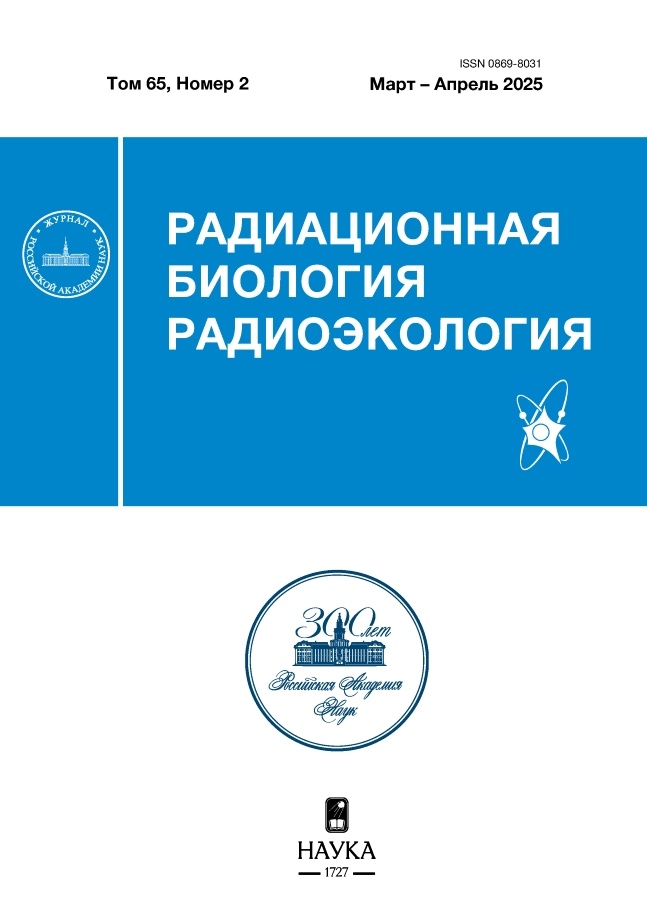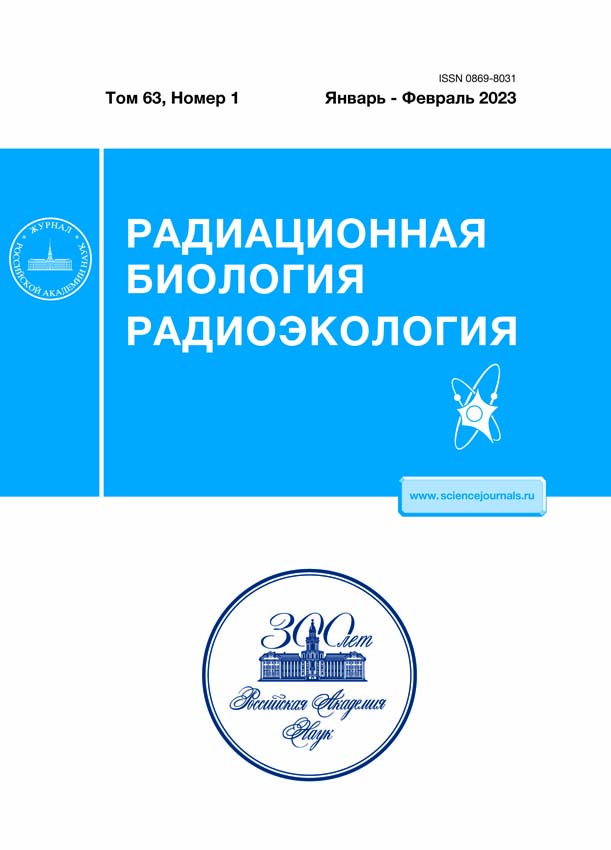СВЯЗЬ ОДНОНУКЛЕОТИДНЫХ ПОЛИМОРФИЗМОВ ГЕНОВ КОНТРОЛЯ АПОПТОЗА И КЛЕТОЧНОГО ЦИКЛА С РИСКОМ РАЗВИТИЯ ЗЛОКАЧЕСТВЕННЫХ НОВООБРАЗОВАНИЙ У ЛИЦ, ПОДВЕРГШИХСЯ ХРОНИЧЕСКОМУ РАДИАЦИОННОМУ ВОЗДЕЙСТВИЮ
- Авторы: Блинова Е.А.1,2, Янишевская М.А.1, Кореченкова А.В.1, Аклеев А.В.1,2
-
Учреждения:
- Уральский научно-практический центр радиационной медицины
- Челябинский государственный университет
- Выпуск: Том 63, № 1 (2023)
- Страницы: 60-70
- Раздел: Радиационная генетика
- URL: https://rjeid.com/0869-8031/article/view/661145
- DOI: https://doi.org/10.31857/S0869803123010046
- EDN: https://elibrary.ru/JWGPFS
- ID: 661145
Цитировать
Полный текст
Аннотация
Целью настоящей работы было исследование связи однонуклеотидных полиморфизмов генов, участвующих в контроле клеточного цикла (ATM rs664677, MDM2 rs2279744, CDKN1A rs1801270) и апоптоза (BCL-2 rs2279115, BAX rs4645878, TNFα rs361525) с риском развития солидных злокачественных новообразований у лиц различных этнических групп, подвергшихся хроническому радиационному воздействию. В исследование было включено 915 человек из двух этнических групп (славяне и тюрки), проживающих в прибрежных селах р. Теча и подвергшихся низкоинтенсивному хроническому радиационному воздействию в диапазоне малых и средних доз. Из них 310 человек имели солидные онкологические заболевания. Методом ПЦР в реальном времени проводилось генотипирование полиморфных участков генов, регулирующих клеточный цикл и апоптоз. В результате проведенного исследования было установлено, что у подвергшихся облучению лиц из тюркской этнической группы аллель rs2279744*С гена MDM2 ассоциирован с повышенным риском развития ЗНО (ОШ = 2.29; 95%-ный ДИ 1.23–4.28; p = 0.007), а аллель rs1801270*A гена CDKN1A является протективным в отношении риска развития ЗНО (ОШ = 0.55; 95%-ный ДИ 0.35–0.85; p = 0.01). Совместное влияние выявленных полиморфизмов и дозы облучения мягких тканей статистически значимо модифицирует риск развития ЗНО у хронически облученных лиц из тюркской этнической группы, при этом наибольший вклад вносит носительство аллеля rs2279744*С гена MDM2.
Ключевые слова
Об авторах
Е. А. Блинова
Уральский научно-практический центр радиационной медицины; Челябинский государственный университет
Автор, ответственный за переписку.
Email: blinova@urcrm.ru
Россия, Челябинск; Россия, Челябинск
М. А. Янишевская
Уральский научно-практический центр радиационной медицины
Email: blinova@urcrm.ru
Россия, Челябинск
А. В. Кореченкова
Уральский научно-практический центр радиационной медицины
Email: blinova@urcrm.ru
Россия, Челябинск
А. В. Аклеев
Уральский научно-практический центр радиационной медицины; Челябинский государственный университет
Email: blinova@urcrm.ru
Россия, Челябинск; Россия, Челябинск
Список литературы
- IARC Working Group on the Evaluation of Carcinogenic Risks to Humans. Arsenic, metals, fibres, and dusts. IARC Monogr. Eval. Carcinog. Risks Hum. 2012. 100 c.
- Davis F.G., Yu K.L., Preston D. et al. Solid Cancer Incidence in the Techa River Incidence Cohort: 1956–2007 // Radiat. Res. 2015. V. 184. № 1. P. 56–65. https://doi.org/10.1667/RR14023
- Krestinina L.Y., Kharyuzov Y.E., Epiphanova S.B. et al. Cancer Incidence after In Utero Exposure to Ionizing Radiation in Techa River Residents // Radiat. Res. 2017. V. 188. № 3. P. 314–324. https://doi.org/10.1667/RR14695.1
- Schonfeld S.J., Krestinina L.Y., Epifanova S., Degteva M.O., Akleyev A.V., Preston D.L. Solid cancer mortality in the Techa river cohort (1950–2007) // Radiat Res. 2013. V. 179. № 2. P. 183–189. https://doi.org/10.1667/RR2932.1
- Bouffler S.D. Evidence for variation in human radiosensitivity and its potential impact on radiological protection // Ann. ICRP. 2016. V. 45. № 1. P. 280–289. https://doi.org/10.1177/0146645315623158
- Barnett G.C., West C.M., Coles C.E. et al. Standardized total average toxicity score: a scale- and grade-independent measure of late radiotherapy toxicity to facilitate pooling from different studies // Int. J. Radiat. Oncol. Biol. Phys. 2012. V. 82. № 3. P. 1065–1074. https://doi.org/10.1016/j.ijrobp.2011.03.015
- HPA. Human Radiosensitivity. Report of the Independent Advisory Group on Ionising Radiation. Doc. HPA, RCE–21. London: Health Protection Agency, 2013.
- Best T., Li D., Skol A.D. et al. Variants at 6q21 implicate PRDM1 in the etiology of therapy-induced second malignancies after Hodgkin’s lymphoma // Nat. Med. 2011. V. 17. № 8. P. 941–943. https://doi.org/10.1038/nm.2407
- Papadakis E., Soulitzis N., Spandidos D. Association of p53 codon 72 polymorphism with advanced lung cancer: the Arg allele is preferentially retained in tumours arising in Arg/Pro germline heterozygotes // Br. J. Cancer. 2002. V. 87. P. 1013–1018. https://doi.org/10.1038/sj.bjc.6600595
- Chen R., Liu S., Ye H. et al. Association of p53 rs1042522, MDM2 rs2279744 and p21 rs1801270 polymorphisms with retinoblastoma risk and invasion in a Chinese population // Sci. Rep. 2015. V. 5. P. 13300. https://doi.org/10.1038/srep13300
- Gao J., Kang A.J., Lin S. et al. Association between MDM2 rs 2279744 polymorphism and breast cancer susceptibility: a meta-analysis based on 9,788 cases and 11,195 controls // Ther. Clin. Risk. Manag. 2014. V. 10. P. 269–277. https://doi.org/10.2147/TCRM.S60680
- Yao Z., Yang B., Liu Z. et al. Genetic polymorphisms of Bcl-2 promoter in cancer susceptibility and prognosis: a meta-analysis // Oncotarget. 2017. V. 8. № 15. P. 25270–25278.
- Xu T., Kong Z., Zhao H. Relationship Between Tumor Necrosis Factor-α rs361525 Polymorphism and Gastric Cancer Risk: A Meta-Analysis // Front. Physiol. 2018. V. 9. P. 469. https://doi.org/10.3389/fphys.2018.00469
- Дегтева М.О., Напье Б.А., Толстых Е.И. и др. Распределение индивидуальных доз в когорте людей, облученных в результате радиоактивного загрязнения реки Течи // Мед. радиология и радиац. безопасность. 2019. Т. 64. № 3. С. 46–53. [Degteva M.O., Napier B.A., Tolstykh E.I. et al. Individual Dose Distribution in Cohort of People Exposed as a Result of Radioactive Contamination of the Techa River // Medical Radiology and Radiation Safety. 2019. V. 64. № 3. P. 46–53. (In Russ.)]
- Старцев Н.В., Шишкина Е.А., Блинова Е.А., Аклеев А.В. Cправочно-информационный комплекс REGISTR Уральского научно-практического центра радиационной медицины ФМБА России // Мед. радиология и радиац. безопасность. 2022. Т. 67. № 1. С. 46–53. [Starcev N.V., Shishkina E.A., Blinova E.A., Akleev A.V. Cpravochno-informacionnyj kompleks REGISTR Ural’skogo nauchno-prakticheskogo centra radiacionnoj mediciny FMBA Rossii // Medicinskaya radiologiya i radiacionnaya bezopasnost'. 2022. V. 67. № 1. P. 46–53. (In Russ.)]
- Hahn L.W., Ritchie M.D., Moore J.H. Multifactor dimensionality reduction software for detecting gene-gene and gene-environment interactions // Bioinformatics. 2003. V. 19. № 3. P. 376–382. https://doi.org/10.1093/bioinformatics/btf869
- Bond G.L., Hu W., Bond E.E. et al. A single nucleotide polymorphism in the MDM2 promoter attenuates the p53 tumor suppressor pathway and accelerates tumor formation in humans // Cell. 2004. V. 119. № 5. P. 591–602. https://doi.org/10.1016/j.cell.2004.11.022
- Bougeard G., Baert-Desurmont S., Tournier I. et al. Impact of the MDM2 SNP309 and p53 Arg72Pro polymorphism on age of tumour onset in Li-Fraumeni syndrome // J. Med. Genet. 2006. V. 43. № 6. P. 531–533. https://doi.org/10.1136/jmg.2005.037952
- Bond G.L., Hirshfield K.M., Kirchhoff T. et al. MDM2 SNP309 accelerates tumor formation in a gender-specific and hormone-dependent manner // Cancer Res. 2006. V. 66. № 10. P. 5104–5110. https://doi.org/10.1158/0008-5472.CAN-06-0180
- Bond G.L., Menin C., Bertorelle R. et al. MDM2 SNP309 accelerates colorectal tumour formation in wo-men // J. Med. Genet. 2006. V. 43. № 12. P. 950–952. https://doi.org/10.1136/jmg.2006.043539
- Ma Y., Bian J., Cao H. MDM2 SNP309 rs2279744 polymorphism and gastric cancer risk: a meta-analysis // PLoS One. 2013. V. 8. № 2. P. e56918. https://doi.org/10.1371/journal.pone.0056918
- Ma H.B., Huang T., Han F., Chen W.Y. Association between MDM2 promoter SNP309 T/G polymorphism and liver cancer risk – a meta-analysis // Asian Pac. J. Cancer Prev. 2012. V. 13. № 6. P. 2841–2846. https://doi.org/10.7314/apjcp.2012.13.6.2841
- He W., Long J., Xian L., et al. MDM2 SNP309 polymorphism is associated with lung cancer risk in women: A meta-analysis using METAGEN // Exp. Ther. Med. 2012. V. 4. № 4. P. 569–-576. https://doi.org/10.3892/etm.2012.640
- Игнатьева Е.В., Матросова Е.А. Геномная изменчивость в регуляторных районах генов, ассоциированная с заболеваниями человека: механизмы влияния на транскрипцию генов и полногеномные информационные ресурсы, обеспечивающие исследование этих механизмов // Вавиловский журнал генетики и селекции. 2021. 25. № 1. С. 18–29. [Ignatieva E.V., Matrosova E.A. Disease-associated genetic variants in the regulatory regions of human genes: mechanisms of action on transcription and genomic resources for dissecting these mechanisms // Vavilov Journal of Genetics and Breeding. 2021. V. 25. № 1. P. 18–29. (In Russ.)]
- Maurano M.T., Humbert R., Rynes E. et al. Systematic localization of common disease-associated variation in regulatory DNA // Science. 2012. V. 337. № 6099. P. 1190–1195. https://doi.org/10.1126/science.1222794
- Bond G.L., Hu W., Levine A.J. MDM2 is a central node in the p53 pathway: 12 years and counting // Curr. Cancer Drug. Targets. 2005. V. 5. № 1. P. 3–8. https://doi.org/10.2174/1568009053332627
- Atwal G. S., Bond G. L., Metsuyanim S. et al. Haplotype structure and selection of the MDM2 oncogene in humans // Proc. Natl. Acad. Sci. USA. 2007. V. 104. № 11. P. 4524–4529. https://doi.org/10.1073/pnas.061099810
- Zheng L., Tang W., Shi Y. et al. p21 rs3176352 G > C and p73 rs1801173 C > T polymorphisms are associated with an increased risk of esophageal cancer in a Chinese population // PLoS One. 2014. V. 9. № 5. P. e96958. https://doi.org/10.1371/journal.pone.0096958
- Wang N., Wang S., Zhang Q. et al. Association of p21 SNPs and risk of cervical cancer among Chinese wo-men // BMC Cancer. 2012. V. 12. P. 589. https://doi.org/10.1186/1471-2407-12-589
- Vargas-Torres S.L., Portari E.A., Silva A.L. et al. Roles of CDKN1A gene polymorphisms (rs1801270 and rs1059234) in the development of cervical neoplasia // Tumour Biol. 2016. V. 37. № 8. P. 10469–10478. https://doi.org/10.1007/s13277-016-4850-3
- Morgan D. The Cell Cycle: Principles of Control. London: New Science Press, 2007. V. 80. № 3. P. 141–142.
- Barbieri R.B., Bufalo N.E., Secolin R. et al. Polymorphisms of cell cycle control genes influence the deve-lopment of sporadic medullary thyroid carcinoma // Eur. J. Endocrinol. 2014. V. 171. № 6. P. 761–767. https://doi.org/10.1530/EJE-14-0461
Дополнительные файлы













